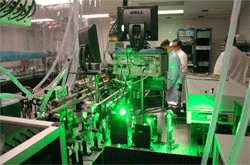A Using optics and expertise developed at LLNL, a laser at the University of Texas has demonstrated more than one quadrillion (1,015) watts (one petawatt) of power. The Texas Petawatt laser is the first of its kind to be completed in the United States since the deactivation of the original petawatt laser at LLNL in 1999.
According to Todd Ditmire of the Texas Center for High Intensity Laser Science, the Texas Petawatt is now the highest-power operating laser in the world. Ditmire thanked LLNL Principal Associate Director Ed Moses and members of the National Ignition Facility and Photon Science Principal Directorate for their help in achieving the milestone. "We couldn't have done it without the help of LLNL and the NIF people," Ditmire said.
The Texas Petawatt laser achieved its power milestone by amplifying a laser pulse to an energy of 190 joules and compressing this energy to a pulse duration of less than 170 femtoseconds (a femtosecond is one quadrillionth of a second). The Texas Petawatt currently is the only laser producing more than a petawatt of power in the United States and only the second such laser constructed worldwide since the first petawatt laser was completed and deactivated at Livermore in the late 1990s (the other such laser is the Vulcan laser at the Rutherford Appleton Laboratory in the UK). A petawatt is 2,000 times the power output of the entire U.S. electrical grid.
The Texas Petawatt uses the same concept as the original petawatt laser built on the NOVA laser at the Laboratory. It takes a short, low-energy laser pulse, stretches it in time by a factor of about 10,000, and amplifies it. It then compresses the final, amplified pulse back down to a duration near that of the initial laser pulse. This technique, known as “chirped pulse amplification,” is used in many of the world’s highest-power lasers, including the Titan laser at LLNL. While based on concepts similar to the initial petawatt laser on NOVA, the Texas Petawatt uses a number of new technologies, which allow it to compress its laser pulses to shorter time durations than the NOVA petawatt, and thereby access petawatt power levels at lower energies than the original petawatt laser.
Ditmire said LLNL was a critical collaborator on the Texas Petawatt project. LLNL scientists from the NIF and Photon Science Principal Directorate assisted the technical team from the University of Texas in the development of many of the laser’s key components. LLNL staffers also played an important role in providing project management guidance for aspects of the project. The final amplifiers of the Texas Petawatt are neodymium, glass amplifiers from the NOVA laser, allocated to the University of Texas after NOVA was shut down. LLNL has played a major role in the refurbishment and activation of these amplifiers. The large gratings needed to compress the Texas Petawatt pulse were also fabricated at LLNL, an optical capability unique to the Lab, Ditmire said.
The Texas Petawatt will be used for fundamental experimental studies of high-energy density plasmas. This includes making plasma states with temperatures exceeding those of fusion plasmas, such as those found in the sun, or pressures exceeding a billion Earth atmospheres. This will allow exploration of the properties of plasmas not usually accessible in university laboratories. The Texas Petawatt also will allow study of many astrophysical phenomena in miniature, such as the explosion of supernovae, the formation of galactic jets, or the properties of matter found in dense stars such as brown dwarfs. The Texas Petawatt also will be used to study aspects of the “fast ignition” approach to inertial confinement fusion, which is aimed at achieving a rapid repetition rate for laser shots in order to make laser fusion energy commercially feasible.
Much of this scientific program will be pursued in collaboration with researchers from National Nuclear Security Administration (NNSA) labs, including scientists from the Lab’s NIF and Photon Science Principal Directorate and the Physical Sciences and Chemistry, Materials, Earth and Life Sciences directorates.
The Texas Center for High Intensity Laser Science is a Stewardship Science Academic Alliance Center of Excellence funded by NNSA. The primary mission of the Texas Petawatt will be to train students in the core areas of high-energy density (HED) physics and ultimately prepare them for work on the large NNSA laser machines. As such, the Texas Petawatt serves as a smaller-scale complement to the NNSA’s suite of large-scale HED machines such as the National Ignition Facility, the Z Machine at Sandia National Laboratories and the OMEGA laser at Rochester University’s Laboratory for Laser Energetics.
Ditmire wrote his Ph.D. thesis in applied science for UC Davis while working at LLNL from 1991 to 1995. He graduated magna cum laude from Harvard University in 1991 with a mater's degree in physics and art history and earned his master's degree in applied science at UC Davis in 1993. Ditmire worked at Imperial College of Science, Technology and Medicine in London from 1995-1997, then returned to LLNL where he was project leader for the Falcon laser project until 2000.

